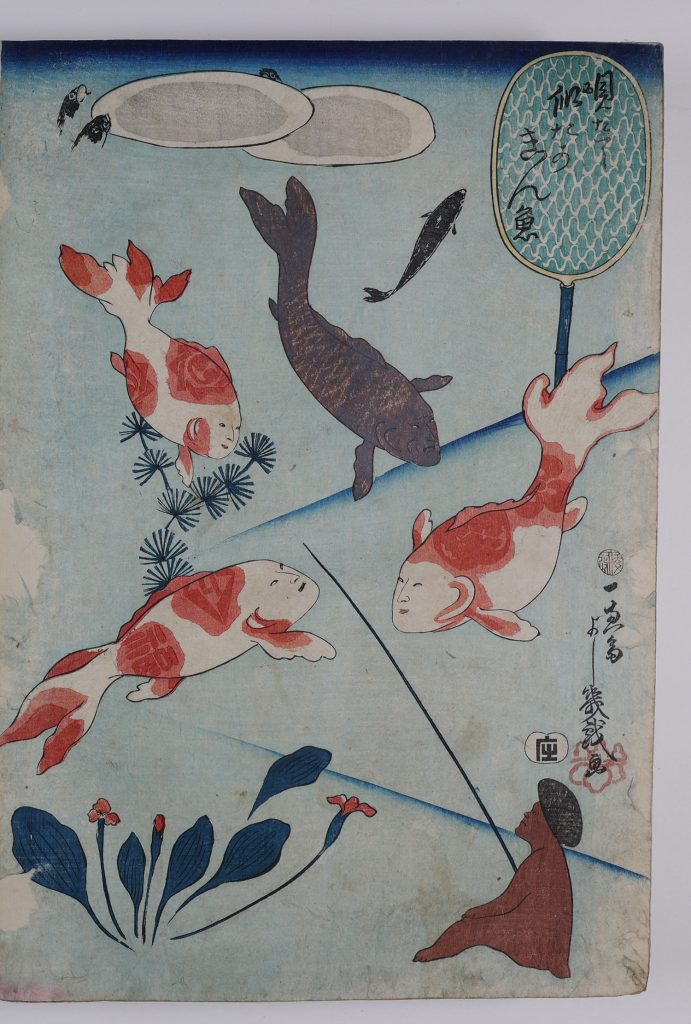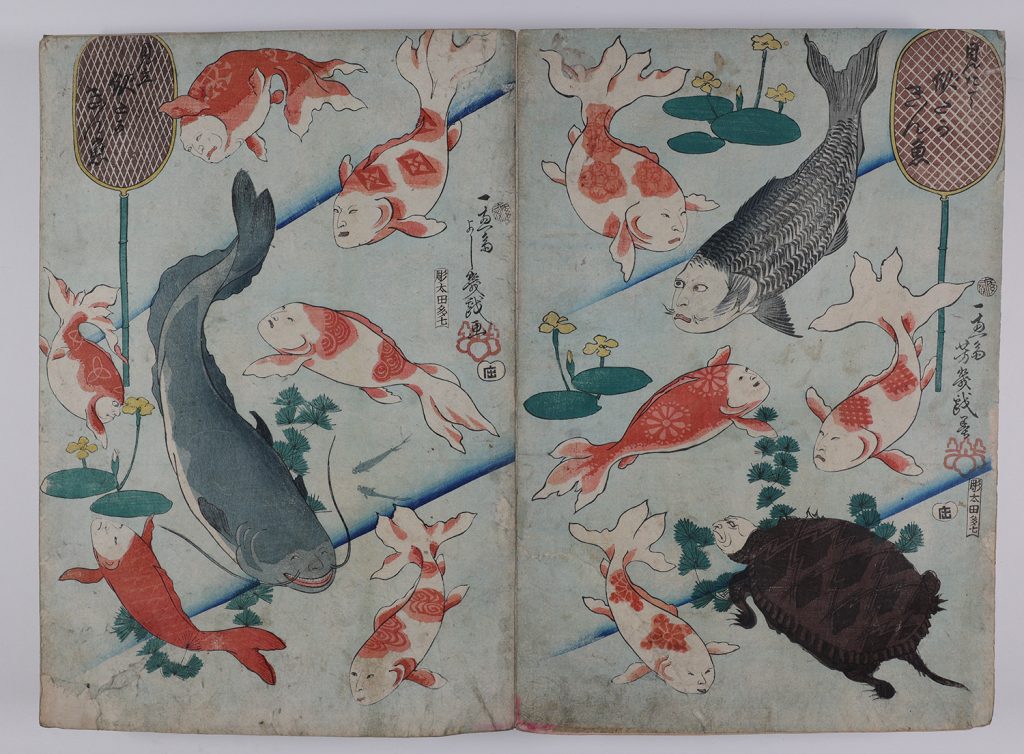Plates 80-82: Does It Look Like Them? A Goldfish Parody
Plates 80-82: Does It Look Like Them? A Goldfish Parody
Utagawa Yoshiiku 歌川芳幾 (1833-1904)
Does It Look Like Them? A Goldfish Parody 見たて似たかきん魚 (6th month of 1863)
Ink and color on paper
Seals:
Publisher: Hayashiya Shōgorō
Censor: Boar 6 aratame
Carver: Hori Ōta Tashichi
Artist: Ikkeisai Yoshiiku giga 恵斎芳幾戯画
Utagawa Yoshiiku’s three-part woodblock print series Does it Look Like Them? A Goldfish Parody presents a surreal aquatic vision. Schools of goldfish, carp, catfish, and turtles swim between lily pads and kelp, but each animal sneers, scowls, or smiles with a distinctly human face. The wide array of emotions Yoshiiku illustrates adds to the absurd comedic effect of the prints. Some fish purse their lips and grimace menacingly while others stare in wide-eyed shock. Yoshiiku uses the wrinkled features of the turtle to full effect to express a sense of exaggerated annoyance. The whiskered catfish grins broadly, revealing an uncanny set of eerily human teeth. The titular question, which is printed on the upright nets in an upper corner of each sheet, points to the fact that each animal caricatures an identifiable kabuki actor. Contemporary print fans would have easily tied the stylized faces to a known public persona, and Yoshiiku cleverly hints to the human identity of each goldfish by layering actor family crests into the pattern of red and pink scales.
Yoshiiku’s grounding for the series stems from his training as a student of the innovative woodblock print artist Utagawa Kuniyoshi 歌川国芳 (1798-1861) in the late 1840s. The fish-human hybrid motif exemplified by Does it Look Like Them? extends a tradition developed by Kuniyoshi as a workaround to the highly restrictive Tenpō Reforms. Put into place by the Tokugawa regime between 1841 and 1843 to consolidate control and improve the morals of the citizens of the capital Edo, the reforms outlawed several professions on the fringes of the floating world and enacted a strict prohibition on depictions of some common ukiyo-e subjects, including portraits of famous kabuki actors, prostitutes, and geisha. Rather than eschewing illustrations of popular figures altogether, Kuniyoshi developed a creative circumvention of the regulations. Inspired by his large collection of Western satirical prints, the artist created playful scenes of popular actors disguised within whimsical groupings of anthropomorphized cats, turtles, birds, and fish. Details like actor crests, props, and stylized faces in each animal-human hybrid cheekily point to a specific public persona. The identities of the figures would have been highly recognizable to the contemporary Japanese audience, but the resemblance was evident without being illegal. In truth, Kuniyoshi need not have gone so far to disguise his figures, indicating that his humorous and exaggerated depictions were meant to parody the absurdities of the Tenpō Reforms, which had ceased to be to be strictly enforced by the mid-1840s. Yoshiiku’s inheritance of Kuniyoshi’s eye for satire would serve him well as he went on to pioneer nishiki-e shinbun 錦絵新聞, or color illustrated newspapers, co-founding “Tokyo Illustrated Newspaper”(Tōkyō eiri shinbun 東京繪入新聞) in 1876.
Printed in 1863, this set stands as the last know production by publisher Hayashiya Shōgorō.
Cainie Brown
Anthropology & History of Art and Architecture
Class of 2022
Annotated Bibliography
Forgione, Nancy. “The Shadow Only: Shadow and Silhouette in Late Nineteenth- Century Paris.” The Art Bulletin 81, no. 3 (September 1999): 490-512.
Discussing the foregrounding of shadows and silhouettes as a motif in Parisian art and design during the late nineteenth century, Nancy Forgione highlights the influence of Japanese prints, particularly those of Utagawa Kuniyoshi and his student Utagawa Yoshiiku, in the development of shadow modeling in an innovative and partially abstracted entity. Relevant to the goldfish print, it emphasizes both the intersection of European and Japanese design and the experimental and creative qualities of Kuniyoshi and Yoshiiku’s prints.
Mark, Andreas. Japanese Woodblock Prints: Artists, Publishers, and Masterworks 1680-1900. North Clarendon, Vermont: Tuttle Publishing, 2010.
Mark’s comprehensive collection provides a concise biography of Yoshiiku, emphasizing his humorous and satirical work and his later transition to newspaper illustration. Mark also includes an entry on the relatively short career of publisher Hayashiya Shōgorō, for whom “Imaginary Look-Alike Goldfish” was his last known production.
Newland, Amy Reigle. The Hotei Encyclopedia of Japanese Woodblock Prints. Leiden: Brill, 2005.
Newland’s Hotei Encyclopedia presents a comprehensive overview of Japanese woodblock prints as a medium, artists, and publishers. Newland emphasizes Yoshiiku in relation to his work with Japanese newspapers and the origins of nishiki-e shinbun, a combination of woodblock prints and newspaper stories.
“Ochiai Yoshiiku.” Tokyo: Ota Memorial Museum of Art, 3 August-26 August 2018. http://www.ukiyoe-ota-muse.jp/exhibition/2018index/yoshiiku.
The Ota Memorial Museum of Art’s solo presentation of Yoshiiku foregrounds the artist as an oft-overlooked woodblock innovator. The exhibition focuses on Yoshiiku as the “inheritor” of Kuniyoshi Utagawa’s quirky and unusual style, including his anthropomorphized animal-actor hybrids.
Takeuchi, Melinda. “Kuniyoshi’s “Minamoto Raikō” and “the Earth Spider”: Demons and Protest in Late Tokugawa Japan.” Ars Orientalis vol. 17 (1987): 5-38.
Looking specifically at Kuniyoshi’s melding of mythology and protest, Takeuchi explores Kuniyoshi’s woodblock production and the intersection between print artists, satire, and censorship during the Tokugawa Regime. She also provides a brief overview of Kuniyoshi’s life, oeuvre, and “decadent” style.
Thompson, Sarah E. and H.D. Harootunian, eds. Undercurrents in the Floating World: Censorship and Japanese Prints. New York: The Asia Society Galleries,1991.
Accompanying an exhibition of the artistic response to evolving Japanese censorship trends, Thompson and Haroontunian’s book presents a history of censorship and moral regulation during different dynastic changeovers and a discussion of the emerging visual trends. Thompson discusses Utagawa Kuniyoshi’s creative workaround to the Tondō Reforms, particularly his disguised actor portraits.
“Utagawa Kuniyoshi.” Tokyo: Ota Memorial Museum of Art, 4 September-24 October 2021. http://www.ukiyoe-ota-muse.jp/exhibition-eng/kuniyoshi21-eng.
This exhibition from the Ota Memorial Museum of Art, curated in the wake of the COVID-19 pandemic, highlights Kuniyoshi’s joyous, humorous, and creative caricatures printed in the face of adversity—namely the restrictive Tempō Reforms. They particularly emphasize his work depicting popular figures in disguise as cats, birds, and graffiti on the 160th anniversary of the artist’s death.
“Does It Look Like Them? A Goldfish Parody (Mitate nita ka kingyô): Fish andTurtle with Faces of Actors.” Museum of Fine Arts Boston. https://collections.mfa.org/objects/472214/does-it-look-like-them-a-goldfish-parody-mitate-nita-ka-ki?ctx=f2339731-aea4-4492-9910-a75df3434bda&idx=200.


